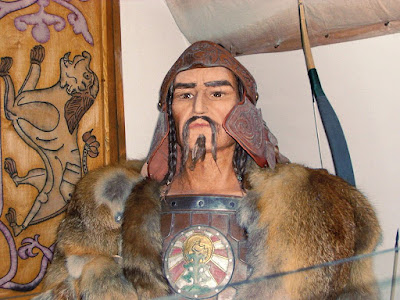Attila was the ruler of the Huns from 434 until his death in March 453. He was called "Scourge of God" by the Romans, "Etzel" by the Germans, "Ethele" by the Hungarians and something unrepeatable by a lot of people.
Little is known of Attila’s early life beyond the fact that he was a member of the ruling family of the Huns, a nomadic Asian people who spread from the Caspian steppes in repeated incursions on the Roman Empire. His warlord father Rugila was a major factor in the Huns' early victories over the Roman Empire.
Priscus, a historian who travelled with Maximin on an embassy from Theodosius II in 448 described Attila. He said he was: "Short of stature, with a broad chest and a large head; his eyes were small, his beard thin and sprinkled with grey; and he had a flat nose and a swarthy complexion, showing the evidences of his origin."
 |
| Figure of Attila in a museum in Hungary By A.Berger |
Attila was known as a feared military commander. During his reign, he crossed the Danube twice and plundered the Balkans. Constantinople was saved only because the Hunnish army, primarily a cavalry force, lacked the technique of besieging a great city.
He invaded Roman Gaul (modern France), crossing the Rhine in 451 and marching as far as Aurelianum (Orléans) before being stopped in the Battle of Châlons, the only battle he ever lost.
In 451 when Attila was on the march in Gaul the French withdrew more and more inside their country until it seemed Paris would fall. However a Christian girl, Genevieve promised the Parisians that if they prayed to God and didn't flee Attila would not come. He didn't. He was defeated at Chalons and was forced to retreat. The Parisians rejoiced and Genevieve was canonized.
Attila retreated to the Rhine then turned his attention to Italy, devastating Aquileia, Milan, Padua, and other towns in the northern provinces. The Hun commander occupied the Imperial Palace in Milan where he had all the paintings altered to show the Roman Emperor kneeling at his feet.
Attila planned for further campaigns against the Romans, but died in 453.
The Romans complained how much Attila and his fellow Huns smelled. The Barbarians had not got into the Roman habit of bathing.
Attila was a skilled archer. He and his fellow Huns shot their arrows from horseback at full gallop with unerring accuracy.
Attila had a fairly superficial Arian Christian faith which at least helped him to maintain certain high standards of Christian morality. Most of the conquering Barbarian tribes were in fact Arian Christians, so much church property was left unransacked, as they had tremendous reference for Christian relics and treasures.
Attila indirectly founded a great city. The story goes that families fleeing Attila and his hordes ended up in a series of mudbanks within a lagoon at the head of the Adriatic Sea. They stayed there, the settlement grew and it became Venice.
Despite being short, squat and ugly Attila acquired 12 wives. Attila's 12th wife was Ildico, a beautiful German. However he died on their wedding night.
Attila was a skilled archer. He and his fellow Huns shot their arrows from horseback at full gallop with unerring accuracy.
Attila had a fairly superficial Arian Christian faith which at least helped him to maintain certain high standards of Christian morality. Most of the conquering Barbarian tribes were in fact Arian Christians, so much church property was left unransacked, as they had tremendous reference for Christian relics and treasures.
Attila indirectly founded a great city. The story goes that families fleeing Attila and his hordes ended up in a series of mudbanks within a lagoon at the head of the Adriatic Sea. They stayed there, the settlement grew and it became Venice.
Despite being short, squat and ugly Attila acquired 12 wives. Attila's 12th wife was Ildico, a beautiful German. However he died on their wedding night.
There are conflicting accounts that Attila was poisoned, had a severe nosebleed or according to the Roman Count Marcellinus "pierced by the hand and blade of his wife."
When Attila died, his troops cut his hair and slashed their faces "to mourn with blood rather than tears."
The unfortunate men who buried Attila and his treasures were put to death so that his burial place would remain unknown.
No comments:
Post a Comment